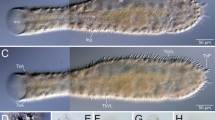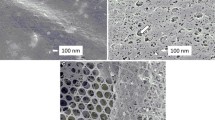Summary
The dorsal and subventral esophageal glands and their secretory granules in the root-knot nematodeMeloidogyne incognita changed during parasitism of plants. The subventral esophageal glands shrank and the dorsal gland enlarged with the onset of parasitism. While secretory granules formed by both types of glands were spherical, membrane-bound, and Golgi derived, the granules differed in morphology and size between the two types of glands. Subventral gland extensions in preparasitic second-stage juveniles were packed with secretory granules which varied in diameter from 700–1,100 nm and had a finely granular matrix. Within the matrix of each subventral gland granule was an electron-transparent core that contained minute spherical vesicles. The size and position of the core varied within different granules. Few granules were present in the dorsal gland extension in preparasitic juveniles. The matrix of dorsal gland secretory granules formed during parasitism was homogeneous and more electron-dense than the matrix of subventral gland granules. Subventral gland secretory granules of parasitic juveniles and adult females appeared degenerate.
Similar content being viewed by others
References
Anderson RV, Byers JR (1975) Ultrastructure of the esophageal procorpus in the plant parasitic nematode,Tylenchorhynchus dubius, and functional aspects in relation to feeding. Can J Zoo 53: 1581–1595
Baldwin JG, Hirschmann H, Triantaphyllou AC (1977) Comparative fine structure of the esophagus of males ofHeterodera glycines andMeloidogyne incognita. Nematologica 8: 239–252
Bird AF (1968) Changes associated with parasitism in nematodes. III. Ultrastructure of the egg shell, larval cuticle, and contents of the subventral esophageal glands inMeloidogyne javanica, with some observations on hatching. J Parasitol 54: 475–489
— (1969) Changes associated with parasitism in nematodes. V. Ultrastructure of the stylet exudation and dorsal esophageal gland contents of femaleMeloidogyne javanica. J Parasitol 55: 337–345
— (1983) Changes in the dimensions of the esophageal glands in root-knot nematodes during the onset of parasitism. Int J Parasitol 13: 343–348
Burgess TL, Kelly RB (1987) Constitutive and regulated secretion of proteins. Annu Rev Cell Biol 3: 243–293
Endo BY (1984) Ultrastructure of the esophagus of larvae of the soybean cyst nematode,Heterodera glycines. Proc Helminthol Soc Wash 51: 1–24
— (1987) Ultrastructure of esophageal gland secretory granules in juveniles ofHeterodera glycines. J Nematol 19: 469–483
—, Wergin WP (1988) Ultrastructure of the second-stage juvenile of the root-knot nematode,Meloidogyne incognita. Proc Helminthol Soc Wash 55. 286–316
Hussey RS (1989 a) Disease-inducing secretions of plant-parasitic nematodes. Annu Rev Phytopathol 27: 123–141
— (1989 b) Monoclonal antibodies to secretory granules in esophageal glands ofMeloidogyne species. J Nematol 21: 392–398
- Paguio OR, Seabury F (1990) Localization and purification of a secretory protein from the esophageal glands ofMeloidogyne incognita with a monoclonal antibody. Phytopathology 80 (in press)
Hoch HC (1986) Freeze-substitution of fungi. In: Aldrich HC, Todd WJ (eds) Ultrastructure techniques for microorganisms. Plenum, New York, pp 183–212
McClure MA, von Mende N (1987) Induced salivation in plantparasitic nematodes. Phytopathology 77: 1463–1469
Mims CW, Richardson EA, Roberson RW (1988 a) Ultrastructure of freeze-substituted and chemically fixed basidiospores ofGymnosporangium juniperi-virginianae. Mycologia 80: 356–364
— —, Taylor J (1988 b) Specimen orientation for transmission electron microscopic studies of fungal germ tubes and apporessoria on artificial membranes and leaf surfaces. Mycologia 80: 586–590
Moore HH, Orci L, Oster GF (1988) Biogenesis of secretory vesicles. In: Das RC, Robbins PW (eds) Protein transfer and organelle biogenesis. Academic Press, New York, pp 521–561
Spurr AR (1969) A low viscosity epoxy resin embedding medium for electron microscopy. J Ultrastruct Res 26: 31–34
Sundermann CA, Hussey RS (1988) Ultrastructural cytochemistry of secretory granules of esophageal glands ofMeloidogyne incognita. J Nematol 20: 141–149
Wyss U, Zunke U (1986) Observations on the behaviour of secondstage juveniles ofHeterodera schachtii inside host roots. Revue Nematol 9: 153–165
Author information
Authors and Affiliations
Rights and permissions
About this article
Cite this article
Hussey, R.S., Mims, C.W. Ultrastructure of esophageal glands and their secretory granules in the root-knot nematodeMeloidogyne incognita . Protoplasma 156, 9–18 (1990). https://doi.org/10.1007/BF01666501
Received:
Accepted:
Issue Date:
DOI: https://doi.org/10.1007/BF01666501




